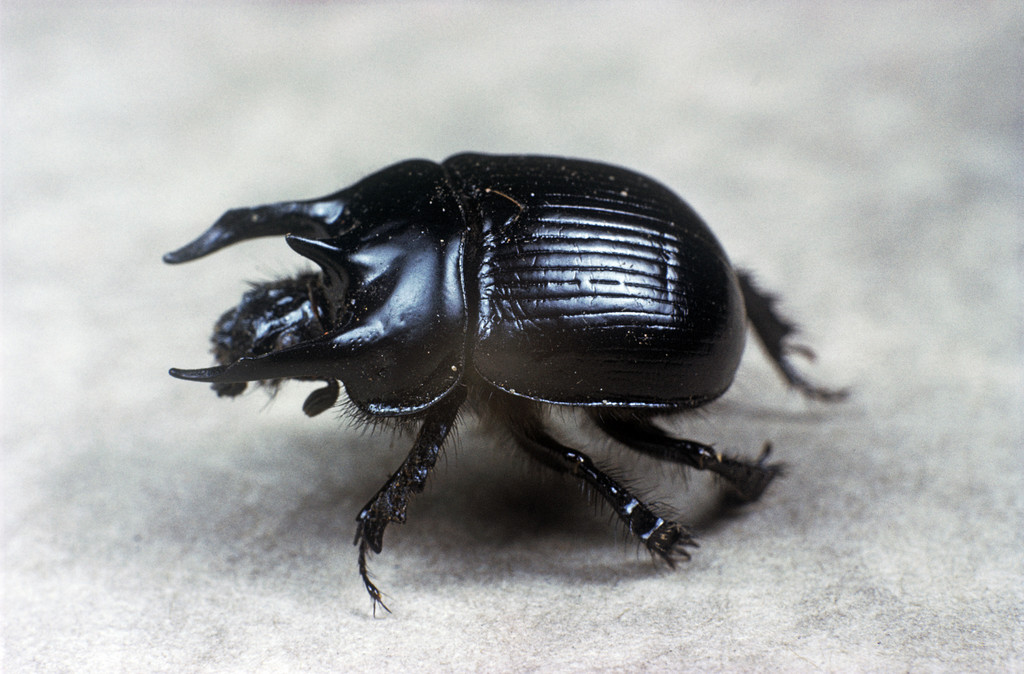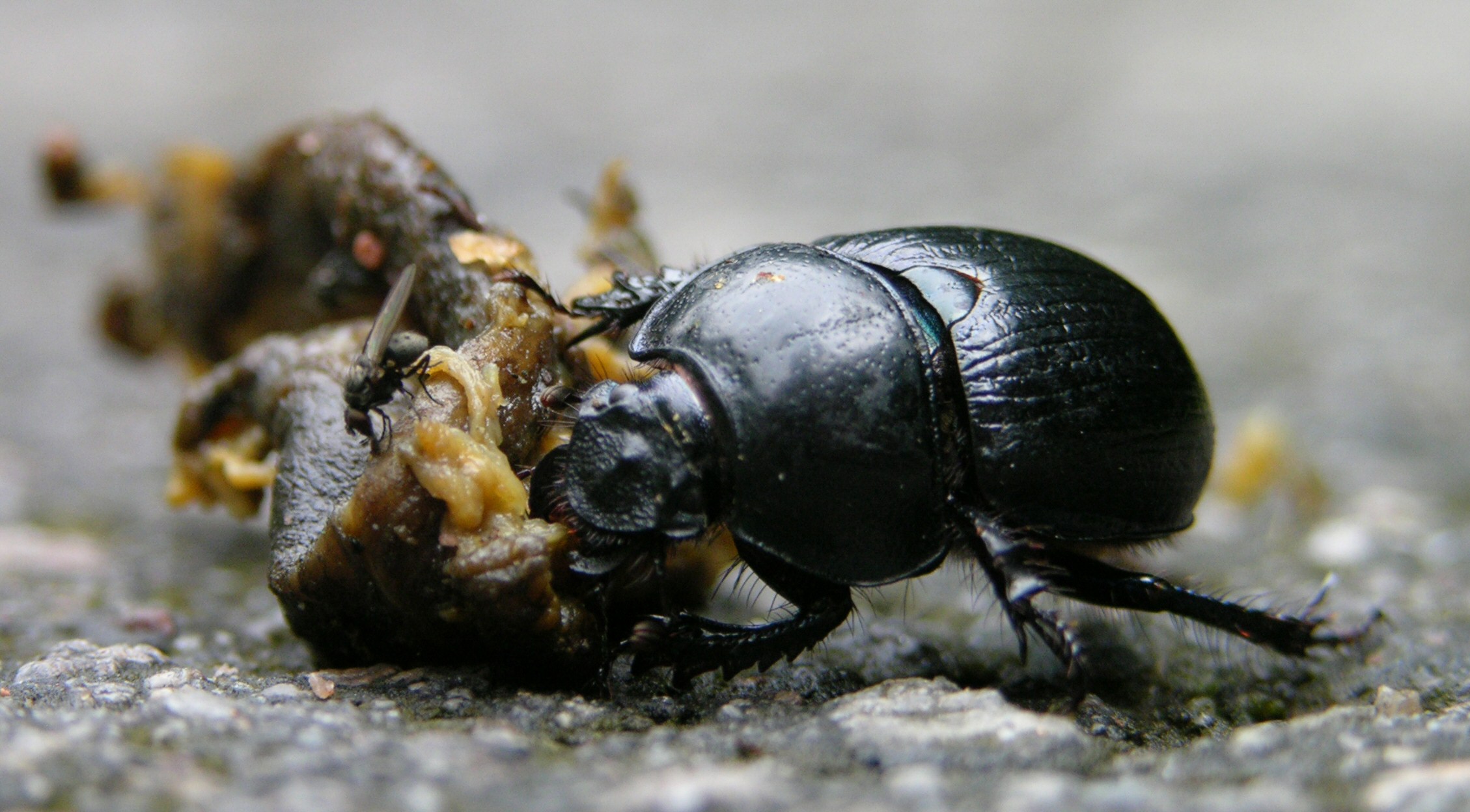- Home
- Garden Wildlife
- Insects
- Beetles
- Dung beetles
Dung Beetles
Various mammals can leave significant deposits of excrement in gardens. These include cats, dogs, fox and rabbits. Excrement can also be brought into gardens in the form of fresh farmyard or stable manure. Bird excrement generally has little attraction for insects. The most important groups of beetles associated with dung are beetles in the families Scarabaeidae and Geotrupidae.
Species in Britain and Ireland
In Britain we have two families of dung beetles, both within the super-family Scarabaeoidea. (This large group also includes the chafers, click-beetles and weevils). There are eight species in the Geotrupidae family which are chunky black beetles, sometimes called dor beetles and are up to 20mm long. Geotrupes stercorarius and Anoplotrupes stercorosus are widespread geotrupid beetles. Males of the minotaur beetle, Typhaeus typhoeus, have three prongs that project forward from the thorax. This species occurs in sandy areas and is particularly associated with rabbit dung.
Biology
Adult dung beetles are active between spring and autumn, with peaks in activity in spring and late summer-autumn. The adults are attracted to the smell of mammal excrement, sometimes alighting on it within seconds of it being deposited. Dor beetles tend to fly in early evening, while other dung beetles are mainly day flying.
Life cycle
Dor beetles make tunnels in the soil beneath or near where dung has been deposited. Both males and females collect dung and carry it down to a chamber at the bottom of the shaft they have created. This can be a metre or more deep in the case of the minotaur beetle. Eggs are laid on the stored dung and the larvae feed on this material. When fully fed they pupate underground and later emerge as adult beetles.
Other British dung beetles, such as Aphodius and Onthophagus species, do not dig tunnels. They lay their eggs beneath the animal droppings and the larvae develop at soil level.
Role of dung beetles in gardens
Dung beetles and their larvae help to prevent an accumulation of mammal excrement on the ground. Without them pastures would become fouled with the dung produced by large grazing animals, such as horses, sheep and cattle.
Other sources of information
Websites
Dung beetles direct A website with information about dung beetles
Books
Jessop, L. (1986) Handbooks for the Identification of British Insects Vol 5 part 11. Dung beetles and chafers (Coleoptera:Scarabaeoidea). – out of print but available as a free download
By Andrew Halstead reviewed by Andrew Salisbury edited by Steve Head

![Photo: Rasbak [CC BY-SA 3.0 (http://creativecommons.org/licenses/by-sa/3.0/)]](images/Geotrupes.jpg)
The Scarabaeinae family, most of which are associated with dung, include the egyptian sacred scarab. They either bury dung in tunnels, or are dung-ball rollers The 66 British species include Aphodius and Onthophagus species, which are mostly brownish black beetles 4-10mm long.

Geotrupid dung beetles. Top left: Geotrupes stercorarius up to 2.5cm long. Upper right: the similar Anoplotrupes stercorosus 12-20mm long dealing with a dead snail.
Left: Minotaur beetle, Typhaeus typhoeus 12-20mm
![Photo: Udo Schmidt from Deutschland [CC BY-SA 2.0 (https://creativecommons.org/licenses/by-sa/2.0)], via Wikimedia Commons](images/acrossus.jpg)
Acrossus rufipes (previously Aphodius rufipes) Onthophagus similis
_Male_(lateral_view)_(19470273679).jpg)
Dung Beetles
Various mammals can leave significant deposits of excrement in gardens. These include cats, dogs, fox and rabbits. Excrement can also be brought into gardens in the form of fresh farmyard or stable manure. Bird excrement generally has little attraction for insects. The most important groups of beetles associated with dung are beetles in the families Scarabaeidae and Geotrupidae.
Species in Britain and Ireland
In Britain we have two families of dung beetles, both within the super-family Scarabaeoidea. (This large group also includes the chafers, click-beetles and weevils). There are eight species in the Geotrupidae family which are chunky black beetles, sometimes called dor beetles and are up to 20mm long. Geotrupes stercorarius and Anoplotrupes stercorosus are widespread geotrupid beetles. Males of the minotaur beetle, Typhaeus typhoeus, have three prongs that project forward from the thorax. This species occurs in sandy areas and is particularly associated with rabbit dung.

![Photo: Rasbak [CC BY-SA 3.0 (http://creativecommons.org/licenses/by-sa/3.0/)]](images/Geotrupes.jpg)

Geotrupid dung beetles. Top left: Geotrupes stercorarius up to 2.5cm long. Upper right: the similar Anoplotrupes stercorosus 12-20mm long dealing with a dead snail.
Left: Minotaur beetle, Typhaeus typhoeus 12-20mm
![Photo: Udo Schmidt from Deutschland [CC BY-SA 2.0 (https://creativecommons.org/licenses/by-sa/2.0)], via Wikimedia Commons](images/acrossus.jpg)
_Male_(lateral_view)_(19470273679).jpg)
The Scarabaeinae family, most of which are associated with dung, include the Egyptian sacred scarab. They either bury dung in tunnels, or are dung-ball rollers The 66 British species include Aphodius and Onthophagus species, which are mostly brownish black beetles 4-10mm long.
Acrossus rufipes (previously Aphodius rufipes) Onthophagus similis
Biology
Adult dung beetles are active between spring and autumn, with peaks in activity in spring and late summer-autumn. The adults are attracted to the smell of mammal excrement, sometimes alighting on it within seconds of it being deposited. Dor beetles tend to fly in early evening, while other dung beetles are mainly day flying.
Life cycle
Dor beetles make tunnels in the soil beneath or near where dung has been deposited. Both males and females collect dung and carry it down to a chamber at the bottom of the shaft they have created. This can be a metre or more deep in the case of the minotaur beetle. Eggs are laid on the stored dung and the larvae feed on this material. When fully fed they pupate underground and later emerge as adult beetles.
Other British dung beetles, such as Aphodius and Onthophagus species, do not dig tunnels. They lay their eggs beneath the animal droppings and the larvae develop at soil level.
Role of dung beetles in gardens
Dung beetles and their larvae help to prevent an accumulation of mammal excrement on the ground. Without them pastures would become fouled with the dung produced by large grazing animals, such as horses, sheep and cattle.
Other sources of information
Websites
Dung beetles direct A website with information about dung beetles
Books
Jessop, L. (1986) Handbooks for the Identification of British Insects Vol 5 part 11. Dung beetles and chafers (Coleoptera:Scarabaeoidea). – out of print but available as a free download
By Andrew Halstead reviewed by Andrew Salisbury edited by Steve Head












